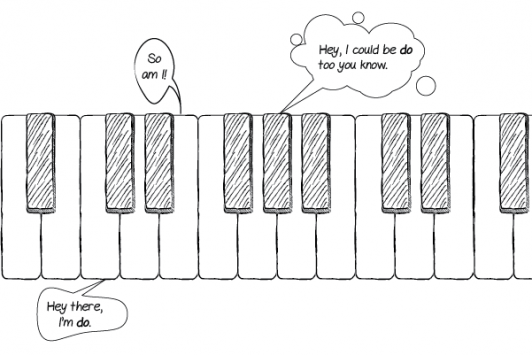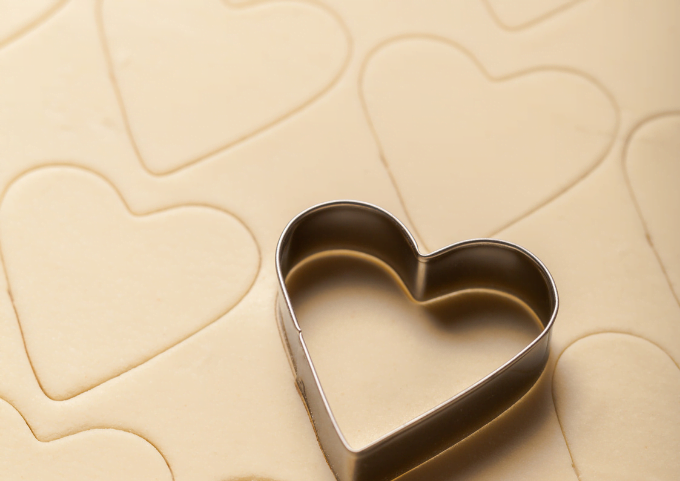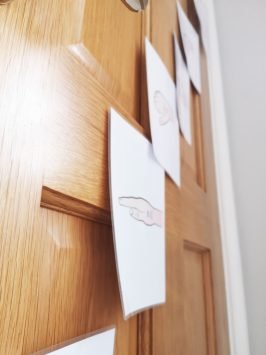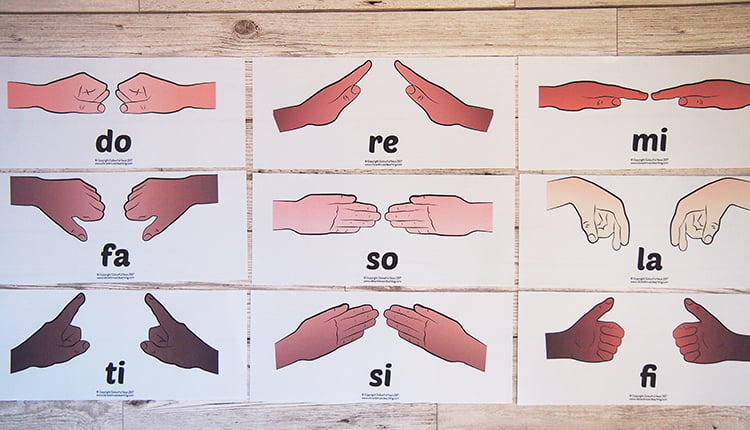The mere mention of solfa can strike fear into the hearts of many piano teachers. Their head is filled with questions and curiosities, not to mention concerns about their own singing abilities.

But solfa can be a fantastic tool to have at your disposal, and it doesn’t have to be difficult or scary. And you certainly don’t have to be a Kodály expert to make good use of solfa in your piano studio.
The content in this post was originally published in 2017 and 2018. It was substantially updated and edited in March 2021.
I’m hoping I can convince you in this article just how powerful solfa can be in the piano studio, and that the simple exercises I share help you feel confident getting started with solfa in your piano lessons.
Side note: This is a heck of a post, so feel free to jump straight to the part you currently need the most:
- What is solfa?
- Why should piano teachers use solfa?
- Getting Started with Solfa
- Solfa Games and Activities
To get started, let’s clear up all the terminology nonsense. What even IS solfa?
What is solfa?
Solfa is simply another musical vocabulary and is particularly useful for singing. If you’ve seen The Sound of Music, you’ll already know that the notes of the major scale in solfa are:
do re mi fa so la ti do
There are additional syllables which are used for sharpened or flattened notes. The only two you’re likely to need are:
- fi – sharpened fa
- si – sharpened so
The reason you probably only need these for now that they’re the sharpened 6th and 7th in the melodic minor scale.
(If that doesn’t make sense to you right now, don’t worry! Just focus on the major scale first. Let’s keep it moving!)
Fixed do…moveable do…huh?!
Part of the big confusion around solfa for piano teachers who haven’t encountered it before is the 2 (or 3) systems.
When I talk about solfa on my blog and elsewhere, I’m referring to “movable do”. That means that do is always the tonic note of the major scale.

For clarity, I refer to a fixed do system as “solfege” (although elsewhere, the words are used interchangeably and inconsistently). In fixed do solfege, do is always C.
Fixed do solfege is really just another way of naming notes. It’s a replacement for C D E F G A B…it does not do the same job that movable do solfa does. Many countries use solfege as their primary note naming system including China, most French speaking countries and most Spanish speaking countries, just to name a few.
In my opinion, there is no point to using both C D E F G A B C and do re mi fa so la ti do to name our notes. If you are in a country which uses the music alphabet, I see no advantage to using this system.
(By the way, I see no disadvantage to using fixed do solfege as your primary note naming method, either. They’re just labels, after all. We could call them flib gib bib tib sib kib hib squib if we wanted. It wouldn’t change the frequency of the pitches.)
OK, but what’s the story with minors?
To muddy the issue even further, some people who use movable do solfa also move the do when the modality changes…in other words, they always make do the tonic of the scale whether the music is major, minor or something else altogether.
On the surface, this might sound sensible. But it actually defeats some of the magic of solfa.
For those of us with good relative pitch (but not absolute pitch,) singing or hearing the E major scale feels about the same as singing the B flat major scale. Sure, if we hear one right after the other, they’re obviously different. But they feel the same in essence because the pattern of intervals is the same.

The minor scale, however, sounds and feels completely different. If we sing do re mi fa so la ti do as both a major scale and a minor scale, it becomes meaningless. Those syllables no longer allow us to develop a feeling of where we are in the scale.
Which is why I prefer a la-based approach to minor scales. Since the relative minor scale starts on the 6th degree of the major scale, it also starts on the 6th syllable in the solfa scale: la.
This essentially means that the solfa follows the key signature, not the scale/modality. It makes for a much more useful tool.
My Favourite Version of Solfa
So to clarify, this is my preferred system of solfa for piano teachers:
- do = the tonic of the major scale of the key signature
- la = the tonic of the minor scale
Now that the confusion is (hopefully) cleared up, let’s get on to why you might want to use moveable do solfa in your piano studio.
What’s the point of solfa for piano teachers?
The first reason is very simple: It’s easy to sing.
Just try singing “G G G E flat, F F F D”. Not very comfortable, is it?
Now sing “mi mi mi do, re re re ti”. Ah, much nicer.
That’s not the only reason, of course. Solfa isn’t just easier to sing – it also gives us more information.
Ear Training
Solfa is my go-to tool for ear training. Take this 3-minute aural skills exercise: It wouldn’t be nearly as impactful if we removed the solfa component. From day 1, students are learning the relationships between notes in a scale – they just don’t realise that’s what they’re learning.
Reading
Because solfa helps us feel relative pitch, it makes it easier for students to “hear” written music in their head. This makes for better readers.

It’s much easier to sight-read music if you already pretty much know how it goes. (If you’ve ever seen a student “read” an impossibly difficult pop rhythm, you’ve seen this effect in action. )
Transposing
By understanding notes in terms of their place in the scale and their relationship to each other, we can instinctively do things which would otherwise be difficult – such as transposing and chord analysis.
Solfa is a great reference point for piano teachers to start a conversation about transposing, using a language kids can understand: “If we make this note mi, where are do and re?”
Sight Singing
Sight singing is actually the reason I started bringing solfa into my piano lessons in the first place. I started using solfa for sight singing because my piano students needed a way to get through the singing test in their piano exams. This took a big weight off my students’ shoulders when it came to exam day.
But then I realised just how powerful singing, especially sight singing with solfa, could be for my piano students. (I go into this in greater detail in this post, if you still need more convincing…)
Getting Started
Now that I’ve convinced you of the merits, let me assure you that anyone can use solfa with their piano students.
Yes, that means YOU!
Don’t try to learn everything at once. Start at level 1, just like your students. Then come back to this post when you’re ready to level up. 😀
Level 1: Do, Re, Mi & So
I’m not a full-on Kodály teacher – I don’t start my students with just so and mi. For me, it’s better to start piano students with do, re, mi and so. I add la later on, and eventually the full major scale. This is comfortable reading territory for piano students and gives them a swift start with solfa.
You can use this video to reinforce the first level of solfa with your students, either in the studio or as an assignment for them to watch at home.
Level 2: Full Solfa Scale
In this next video, I give a quick run down of what solfa notes are for the full scale and the Curwen hand-signs for each one.
As with the beginner video, feel free to send this video to parents for their kids to watch, use it in group lessons or as part of lab time. It’s designed to be clear and concise so that students can watch it – and then get on with some writing work for reinforcement.
Level 3: High and Low Solfa
High and low solfa notes can be a stumbling block for some students. Although they seem very simple, a student could get tripped up here if they think of a scale in a linear do to do way.
Having high and low solfa notes requires an understanding of the scale as a fluid palette of notes that a melody can draw from.
While this might be a sticking point, it’s also a fantastic benefit. Learning this lesson early on gives our piano students a deeper understanding of music theory and the value of scales.
You guessed it: There’s a video for high and low solfa notes, too! This video goes over the concept in general, as well as how to notate high and low solfa.
Solfa Games and Activities for Piano Teachers and Students
I know how it is, with all the myriad of areas we need to cover as music teachers. It can be hard to fit everything into that 30 or 45 minute lesson.
Which is why I need short bursts of singing games. These quick little exercises improve my student’s musical ears – without taking a stressful amount of the lesson away. Perfect for a busy piano curriculum.
Singing Wall Warm-Ups
In my case, singing door warm-ups. This is the quickest and easiest way to ensure some singing with solfa gets included in every lesson – something I’ve been aiming to be more consistent about myself.
Simply stick the Curwen hand sign posters on your wall, bulletin board or the back of a door to create a solfa scale visual. When students come in, you can work on intervals using the solfa syllables within the student’s ability.

A fun extension is to start pointing to notes in a way which will recreate part of a piece they’re working on. See if they notice what you’re doing as they sing! 😉
(For more on Curwen hand signs and how they fit in with solfa, head over to The Clear and Concise Guide to Curwen Hand Signs.)

Subscribe to updates and get the CURWEN HAND SIGN POSTERS
Enter your details to subscribe to the newsletter for piano teachers with information, tips and offers.
I hate spam as much as you do! I'll only send you information that's directly relevant to music teachers and you can unsubscribe at any time.
If you’re a member of Vibrant Music Teaching, you can instantly download printable posters of the Curwen hand signs from the VMT Library to hang in your studio.
Not a member? Sign up today and you’ll get instant access to this and many other solfa resources.
Jumpin’ Solfa
This activity is great to use for reviewing and drilling solfa and the Curwen hand signs, and can also be used to review folk songs or rote pieces. Plus it’s just super fun.
- Lay out the solfa cards loosely on the floor in random order.
- Ask your student to make the major or minor scale (whichever you’re working on).
- Tell her to stand in front of a certain starting note and play it on the piano so she can match the pitch. E.g. tell her to stand in front of la and play the starting note D for a D minor scale.
- Have her jump from one note to the next, singing the scale as she goes. You can both do this together on opposite sides of the cards.
- Then the real fun starts. Ask her to jump to specific solfa notes, or work out Mary Had a Little Lamb, or practice particular intervals. The possibilities for your new vocal floor piano are pretty endless.
Have fun with it and shake out the wiggles! This activity is a great brain break for when you’re working on a tricky piece or when a student’s energy is low.
Make sure to print two do cards if you want a full major scale, or two la cards if you want a full minor scale. You might even like a full two sets so you can do low notes and high notes or different modes.
Vocal Warm-Ups
You can also use singing to work on high and low solfa. Just taking a few minutes at the start of each lesson to sing these simple exercises together is a great investment.
Start with just do–low so. Practice this for several weeks, singing in various rhythms and asking your student to copycat them back to you.
Once she has really grasped do–low so start on do–low la, then do–low ti and so on.
Over time, your student will build up a library of the intervals as part of her internal music vocabulary. Singing and aural tests don’t seem like such a big deal when they’re taught gradually in this way.
Solfa Skyrocket
If you prefer a more structured approach with detailed instructions to get your students movin’ and groovin’ with solfa, then the Solfa Skyrocket course is perfect for you.
Solfa Skyrocket is just one of the many courses available to anyone who is in our membership program for teachers. As part of this course, you’ll get step-by-step lesson plans to immerse your students in solfa for 6 weeks. Even if you’ve never used solfa or you don’t consider yourself much of a singer, Solfa Skyrocket makes it easy.
Not a member? Sign up today and you’ll get instant access to this and many other amazing courses for your own professional development,
Do you use Solfa in your piano studio?
In the comments below, let share your favourite ways for piano teachers to use solfa so we can keep growing our list of fun activities. 🙂

I have really enjoyed your teaching videos and helpful hints. I wondered after looking at your thinking theory books if there is a version that uses the terminology we use here in the U.S.? My teaching has evolved from being focused totally on note reading to finding great value in learning by rote using patterns and seeing how it helps to develop creativity.
Hey Nancy! The Thinking Theory books are indeed available with both types of terminology. Just select “USA version” when you’re adding it to the cart.
Glad you’re enjoying the resources! 🙂
In my country we use Do re mi fa sol system to name the notes but because I teach music in a british school as well I use the alphabet! What I recon is that because notes on the stave have a sequence/order as the alphabet it’s easier to learn how to find them on the stave but using do re mi sounds more musical and some of my piano students tell me that they can hear “do” (e.g) when I play them the note on the piano!
Yes, it’s interesting comparing fixed do and alphabet note names. These are much more similar in fact than movable do and fixed do – which is confusing for some!
For my beginning students I use Old MacDonald singing “mi mi re re do. And on that farm he sang this song: mi mi re re do. With a do do here and a do do there” etc. I play the song on my keyboard and they join in on the piano for the mmrrd on the 3 black keys also finding do in various octaves for the ‘here’ and ‘there’. Later we do this on white keys too, and it really explains the concept of do as the tonic as we learn to navigate the keyboard.
I love this Sarah! I think sometimes I jump too quickly/directly to full songs in solfa but this is a great segway.
I teach voice and flute as well as piano (piano being the instrument in which I have no degree and at which I have no innate talent!) and have always used solfege with all of my students. I have a series of solfege exercises starting with the major scale and its two tetrachords that I also have students learn by rote, and the younger ones love the “challenge” of getting each exercise learned, first in C major, and then in other keys. Thank you for the hand sign posters. I just wish we didn’t have to subscribe anew each time (and then unsubscribe).
Hi Patricia! Thanks for sharing your thoughts, it’s great to get a singing teacher’s perspective!
As for subscribing and unsubscribing. First of all, you do have to subscribe each time – but you don’t have to unsubscribe. You won’t be on the list twice or anything like that.
Second of all, there is a solution to this where all the resources are organised and immediately downloadable: Vibrant Music Teaching. That’s my membership website. I’m happy to provide some resources for free here too and will continue to do so – but it’s up to each individual whether they prefer the free version or the support and convenience of the paid version.
Thanks Nicola! I really enjoyed the post. I’ve been wanting to incorporate more solfa/solfege into my teaching more regularly. These are wonderful ideas!
Great, glad you enjoyed it!
I use moveable DO system with all my piano ( and theory ) students. The most valuable thing it gives them is the fact they can hear (imagine) a melody before starting playing. It means the student fluent in solfa can spot a mistake of finger since she already knows “ what it sounds like”. And what you mentioned before – improves sight reading or singing, transposing is piece of cake for them and singing improves in pitch.
That’s HUGE. 😀
Question! I’d like to use solfa with a few of my younger preschoolers, but am implementing the Piano Safari method, which uses the musical alphabet. Are you saying not to use sofla and teach ABCDEFG at the same time?
No, I’m not saying that at all. I’m talking about movable do solfa, not fixed. Fixed do is instead of CDE movable do should be used as well as because it does a different job.
I have learnt something new from this post on the concept of solfa and it’s really great. This will help me a long way in teaching my students.
I recently tried Solfa for the 1rst time using Hexatonic Pattern Cards. On week 3 the student exclaimed “I like this”! I plan on using Solfa to sing and review a previously learned folk song each week. Thanks for new ideas Nicola.
Awesome! Well done for taking that leap, Marcia!
Thank you for this post– I used the “Jumpin’ Solfa” game yesterday with a student! Our church has been learning shape notes so we can sing in four-part harmony for about a year and a half, and I was excited to see that I can use them for my piano students as well! I’m looking forward to learning more from your site. 🙂
Sounds like fun!
Great
Nice one dear but I still need more pls
I was wondering at what level you introduce solfa singing? Right from the beginning?
Yep!
thanks for the for the educating write up but am just a beginner in solpha and you didn’t explain the basics like meaning of some symbols like; .,/: dc – and the comma above a note and below a note. thanks though.
Hi Oriaku Francis,
The explanations for the symbols are in the videos. For example, at the Level 3 Sections: High and Low Solfa Nicola explains that the comma above a note means a high note (1 octave up) and the comma below the note means the low note, or one octave down.
On the previous videos on level 1 and 2, she shows the hand symbols for the notes and the letter for each note. So “d r m f s l t” are an abbreviation for do re mi fa sol la ti. d’ means high do. So a major scale will be: d r m f s l t d’. The last do has a comma above, meaning it is one octave higher than the first do.